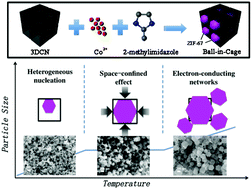Ball-in-cage nanocomposites of metal–organic frameworks and three-dimensional carbon networks: synthesis and capacitive performance†
Abstract
In order to improve the electrical conductivity of metal–organic frameworks (MOFs) which have drawn remarkable attention owing to their potential application in the energy storage field, a Co-based zeolitic imidazolate framework (ZIF-67) polyhedron was in situ integrated into a three-dimensional carbon network (3DCN) to construct a Ball-in-Cage (BIC) nanostructure. The introduced 3DCN acting as the electronic pathway can provide nucleation sites for MOF particles; consequently, further growth of the MOF particles is limited by the size effect of 3DCN. The BIC frame not only controls the MOF particle size, but also ensures a high electron conductivity of the entire structure. The as-prepared BIC electrode displays an outstanding capacitance of 119 F g−1 at a current density of 0.5 A g−1 and a great rate performance as well, which can be expected to be a promising approach to enhance the electrochemical performance of pristine MOFs in the future.



 Please wait while we load your content...
Please wait while we load your content...